Yes, polyurethane can be put over acrylic paint, but it’s not that straightforward. A few things need to be taken into account before doing so. Here in this blog, we’ll cover different views and arguments on whether you can apply polyurethane over acrylics or not.
In addition, we’ll discuss some of the best ways to use polyurethane over acrylics and how long we should wait for acrylics to dry before the application.
And finally, we’ll talk about some personally experienced tips on how to put polyurethane over acrylic paint and how to seal acrylic paint with polyurethane.
Can You Put Polyurethane Over Acrylic Paint?
Yes, you can put both oil-based and water-based polyurethane over acrylic paint. However, oil-based polyurethane has the disadvantage of yellowing the paint over time, while water-based polyurethane has nothing to do with affecting the paint color. But still, both should be applied in clear coats to reduce the chance of spoiling your art.
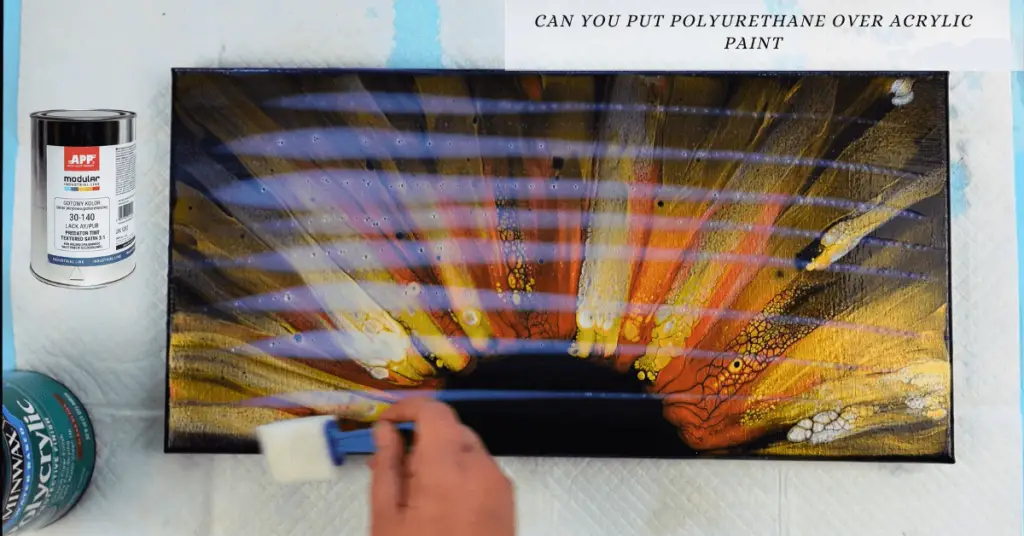
What is Polyurethane?
You must have heard the term “Polyurethane,” especially while shopping for furniture. But what is polyurethane, and why is it given so much importance?
Polyurethane is nothing but a kind of plastic made of two main chemicals, polyisocyanate, and polyol. These materials create a strong bonding together and can be used in a variety of ways.
Polyurethane is popular for its effective applications in furniture. As a coating over the woodwork, it provides a durable finish and protection against spills, damage and stains. Additionally, it is utilised for insulation purposes.
It works by preventing the loss of heat, making it an effective material in many ways.
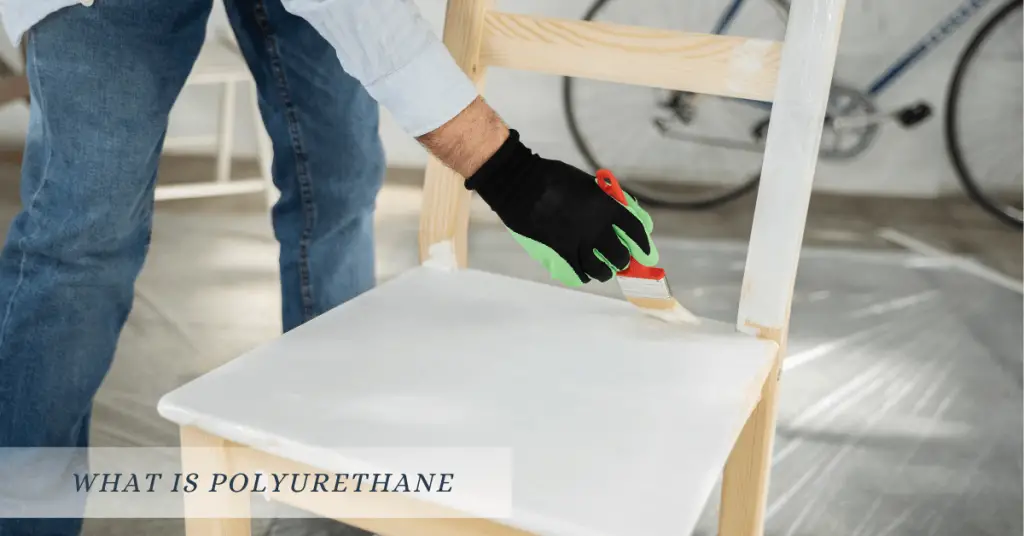
Can You Use Polyurethane On Acrylic Paint?
Now the question arises, “Can you put polyurethane over acrylic paint?” Yes, you can, but some factors need to be known before you do so.
As we know, there are two main types of paints consisting, oil-based and water-based paints. Same as paints, polyurethane can be water and oil-based too.
So never put polyurethane over oil-based paints. However, being water-based, acrylic paints can be coated with polyurethane but don’t ignore the precautions.
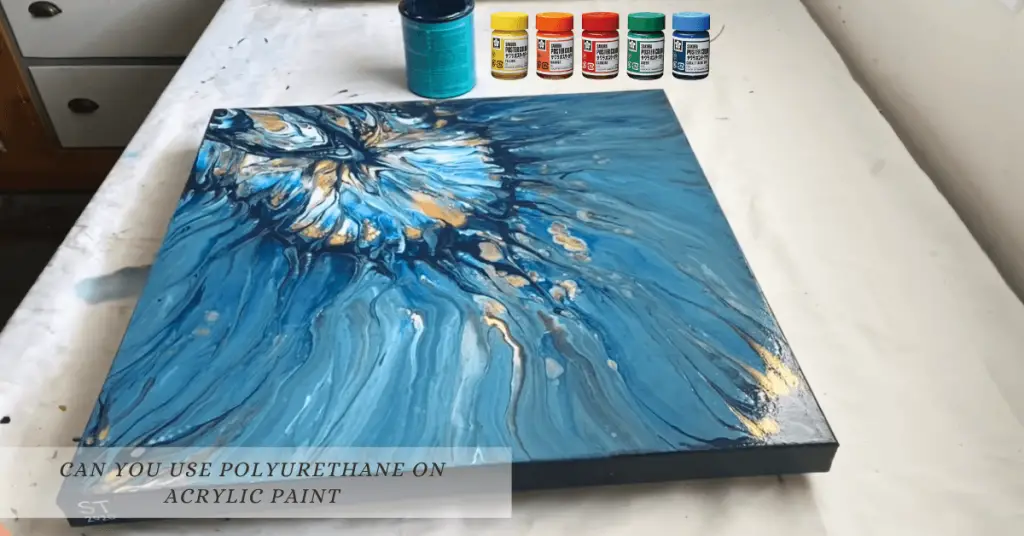
Will Polyurethane Ruin Acrylic Paint?
No, polyurethane will not damage your acrylic paint as long as you have applied the coating following the buyer’s instructions. On the other hand, oil-based paints can respond with yellowing and fading to polyurethane.
In fact, polyurethane coating will provide an even and durable finish to your paint job and protect it from wear and tear.
Does Polyurethane Bond To Acrylic?
Polyurethane can bond to acrylic paint to some extent, but the adhesion may differ due to several factors. Acrylic paint forms a relatively smooth and non-porous surface, which can make it difficult for polyurethane to adhere properly.
However, with the right preparation and application techniques, you can achieve a satisfactory bond between polyurethane and acrylic paint.
What is the Best Polyurethane for Acrylic Paint?
Choosing the right and quality polyurethane for your paint job is quite difficult but don’t worry, as we have your back.
Two types of polyurethane are generally considered usable for paints. Water-based and oil-based. Water-based polyurethane is ideal for use over acrylic paint. The reason is its ability to dry faster. Moreover, it doesn’t alter the appearance of the paint.
Oil-based polyurethane, on the other hand, is not recommended as it can cause the yellowing of the paint.
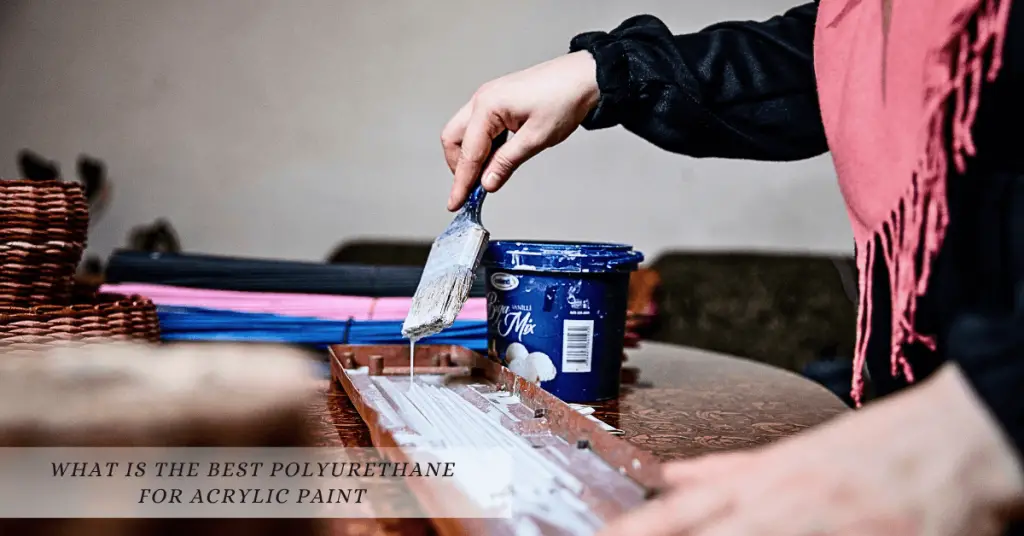
How Long should we wait for Paint to Dry Before Using Polyurethane?
After you have selected a good quality polyurethane, the next step is applying it over your paint. But make sure not to hurry. Let the paint dry well before applying the polyurethane.
If you’re applying it over acrylic paint, ensure the dryness of the paint first. Wait at least a full day before the application. How long acrylic paint takes to dry depends on various factors. However, it usually takes an hour or maybe days. So better to let the paint fully cure before using polyurethane over it.

Can You Seal Acrylic Paint With Polyurethane?
After considering all the crucial factors, it’s time to talk about “how to apply polyurethane over acrylic paint.”
- First of all, your paint needs to be sanded. Because the polyurethane requires a smooth surface to adhere to firmly. Sanding makes the surface even and smooth.
- Begin applying polyurethane after you have sanded the surface thoroughly.
- During application, try to use even strokes of polyurethane, as it will give a uniform look to your final paint. Moreover, avoid over-application.
- After applying polyurethane thoroughly, allow it to get dry. It may take somewhere between 24 to 48 hours, depending on the type.
Minwax Polycrylic Over Acrylic Paint:
After we have covered the question “Can you use polyurethane over acrylic paint” from all aspects, now let’s talk about “Can you use polycrylic over acrylic paint?”
Definitely, yes, you can use it. Minwax polyacrylic is popular to be used over both oil-based paints and water-based paints. It’s a water-based polyurethane with having clear finish.
You can apply it with a brush, sprayer, or roller. It gets dry quickly and gives a durable and clear finish. It’s available in both finishes, gloss, and satin. So choose the one that suits you the most.
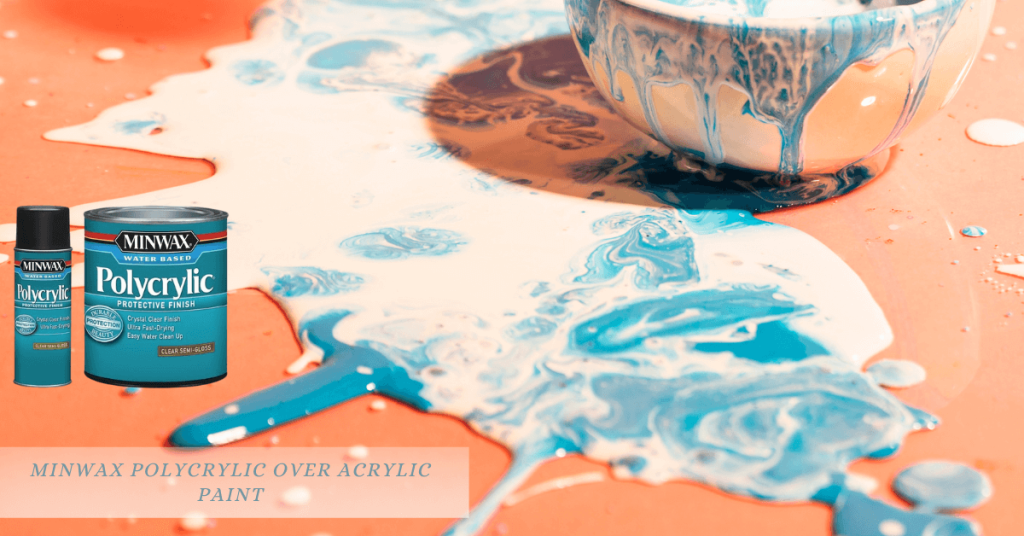
Can You Use Helmsman Spar Urethane Over Acrylic Paint?
Yes, you can use Helmsman Spar Urethane over acrylic paint. It is popular to be used over both oil-based paints and water-based paints. It’s a water-based polyurethane with having clear finish.
You can apply it with a brush, sprayer, or roller. It gets dry quickly and gives a durable and clear finish. It’s available in both finishes, gloss, and satin. So choose the one that suits you the most.
Make sure to apply even stroke when using Spar Urethane and avoid applying in excess. After you have applied the finish, let it dry thoroughly before handling the painting. Depending on various factors, it can take up to 48 hours to get fully dried.
Can You Put Lacquer Over Acrylic Paint?
Yes, you can put lacquer over acrylic paint. Make sure not to apply the lacquer over wet paint as it can cause serious damage to your hardly-painted art.
Let the paint get dry first, as wet paint doesn’t allow the lacquer to adhere firmly, which causes the paint to peel or chip.
You have to be careful while using lacquer as not all are the same. Some are not designed for acrylics and can cause damage to your painting. So better to take an advice of a professional.

Can You Put Oil-based Polyurethane Over Acrylic Paint?
Yes, you can put oil-based polyurethane over acrylic paint. It’s a kind of clear and transparent finish. You can apply it with a brush, sprayer, or roller. It gets dry quickly and gives a durable and clear finish.
Make sure to apply even strokes and avoid applying in excess. After you have applied the oil-based polyurethane, let it dry well before handling the painting. Depending on various factors, it can take up to 48 hours to get fully dried.
Best Polyurethane Clear Coat Over Acrylic Paint:
When it comes to going for the best clear coat over acrylic paint, there are three common options.
- Water based polyurethane
- Oil-based polyurethane
- Lacquer
Each has its own specifications, pros and cons. Better to consider all the factors and select the one that covers your requirements.
- Oil-based polyurethane is one of the clear finishes and can be applied using a brush, sprayer, or sometimes roller. It has the disadvantage of altering the appearance of your paint with time.
- Water-based polyurethane is another clear finish and can be applied using a brush, sprayer, or roller. It gets dry quickly. It can cause a cloudy finish sometimes.
- Finally, lacquer is another option for a clear finish. It is dried faster too but can be harmful to paints underneath if not used properly.
FAQs
Can I put polyurethane over the acrylic paint?
Yes, polyurethane can be put over the paint. For best results, let the paint dry first. Applying the finish over wet paint will eliminate the adherence to the painted surface, and the paint will get peeled out. Moreover, choosing the right polyurethane is crucial as well.
What can I seal over acrylic paint with?
Acrylic paint can be sealed on plastic, metal, wood, canvas and other surfaces with a variety of sealers, but three of them are used commonly, including water-based polyurethane, oil-based polyurethane and lacquer. Each has its own specifications, pros and cons. So choose the one that covers your needs.
Does polyurethane react with acrylic?
No, in most of the paints, polyurethane doesn’t react with acrylics, but some are non-specific and non-compatible with the paints. So better to ask a professional before you spend your money on buying polyurethane.
Can you seal acrylic paint on wood with polyurethane?
Yes, you can do so, but it’s not recommended. Polyurethane may cause damage to acrylic paint and make it hard to clean. Moreover, it fades or yellow the appearance of the paint. So better to use polyurethane specifically designed for woodwork.
Can you use polyurethane over acrylic latex paint?
Yes, you can use polyurethane over acrylic latex paint. But make sure the paint is in good condition. If the paint is damaged, or you can say peeling and flaking, replace it with a fresh one before going for applying polyurethane.
Will polyurethane make acrylic paint glossy?
No, polyurethane doesn’t make acrylic paint glossy but protects it from harsh conditions like UV rays, heat and scratches. Moreover, it gives a durable and clear appearance.
How do I remove polyurethane from acrylic paint?
There are a variety of ways to remove polyurethane from actual paint. Some of the common and popular procedures include chemical stripping and sandpaper. Additionally, a heat gun is found useful in removing the finish too. Taking the advice of a professional is recommended before you apply any procedure.
Can you paint acrylic enamel over urethane primer?
Yes, you can paint acrylic enamel over urethane primer. Typically, urethane primer is used for surfaces exposed to the external environment, so the surface you’re planning to paint should be well-ventilated. The second thing is thinning the primer as it’s quite thicker than usual products. Finally, the urethane primer needs to be cured fully, meaning it should be dried completely before you paint acrylic over it.
Conclusion
So, can you put polyurethane over acrylic paint? Yes, you can put polyurethane on acrylic paint but you must be well informed on the external factors, the response of different paints, and the way of application.
The paint must be compatible with polyurethane and always applied in smooth and even strokes for a professional look. Moreover, thin layers are preferred. And finally, let the polyurethane get dry before going for further procedures.
For queries, appreciation and suggestions, please comment below. Thank you!
- How To Buff Acrylic Enamel Paint In 5 Easy Steps? - February 2, 2024
- How To Make Acrylic Paint More Opaque? 10 Effective Methods - February 1, 2024
- How To Sketch On Canvas Before Acrylic Painting? Draw Like a Pro - January 31, 2024

